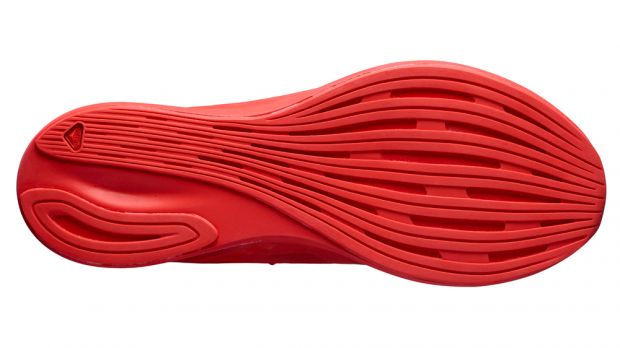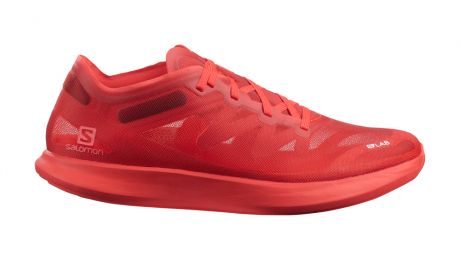For
- Very lightweight
- More comfortable than classic racing flats
- Smooth ride from rocker
Against
- Firmer than high-stack shoes
- No carbon plate for efficiency gains
- High price pits it against better shoes
You can trust Coach
The year is 2021 and carbon plate super-shoes dominate race start lines (or would, if races were allowed), but here’s Salomon with a welcome reminder that not every racing shoe needs to have a carbon plate in it to offer high levels of performance. The Phantasm might be carbon-free, but it’s still fast – and it’s surprisingly comfortable given the relatively low stack compared with the likes of the Nike Vaporfly.
That’s not to say the Phantasm is exactly like the racing flats of yore, with yore being about six years ago in the pre-Vaporfly era. The traditional design was minimalist and light to achieve speed gains, which also meant a very firm ride that was hard on the legs, especially over a half marathon or marathon distance.
The Phantasm takes some cues from modern racers by using a rocker design (or reverse camber, as Salomon terms it) in the midfoot, which helps you roll onto your forefoot and off your toes smoothly with each footstrike. It also employs a fancy lightweight foam called Energy Surge, which is a mix of the common EVA and less common OBC (that’s olefin block copolymers if it means anything to you). While it’s not soft and springy like the PEBA-based foams used in the Vaporfly, I found if similar to the nitro-infused EVA foam used in the Books Hyperion Elite 2 and Tempo shoes in that it isn’t too harsh despite being firmer than PEBA.

With a stack height of 20mm at the heel and 14mm at the forefoot for a drop of 6mm, the Phantasm’s cushioning is half as high as something like the Nike Alphafly, but I didn’t find it uncomfortable or unforgiving even during long workouts. I used the Phantasm for a 17km session involving 24 reps of 60 seconds on/30 seconds off followed by a progression 3km, and a 19km session with two 3km stints and eight 800m reps. Neither left my legs feeling like they had taken an unholy beating in the way I’d expect traditional racing flats to do. On a 24.5km run I was again impressed at the level of protection offered by the cushioning.
The Phantasm is also more forgiving than some of the new lower-stack carbon plate shoes, like On’s Cloudboom or Cloudflash shoes, and perhaps even benefits from not having a plate in that the ride doesn’t become too firm.
It’s also a lightweight shoe at 205g for my UK 9, which is lighter than most of the carbon plate models released last year, though it’s heavier than past racing flats I’ve used as well as the Nike Vaporfly NEXT%, which comes in under 200g.

The upper is a TPU mesh that really nails the barely-there approach taken by many racing shoes. It’s very thin and there’s little padding around the collar and tongue, so it drains and dries quickly in wet conditions, which I can definitely attest to having used it in the UK in January. The shoe fits true to size, but has a slightly narrow design, which makes it easier to get a locked-down fit in the midfoot. If you have a wider foot, being able to try sizes before you buy could definitely be helpful.
Sign up for workout ideas, training advice, reviews of the latest gear and more.
There’s a thin layer of rubber of Salomon’s Contagrip FA material on the outsole, which provided an impressive level of grip during my testing, which included a long run in the snow on treacherous pavements. I think I’ve exclusively run in the shoe in wet conditions and I’ve not slipped so much as an inch, so full marks.
See related
- The Best Running Shoes
- The Best Marathon Running Shoes For Training And Racing
- The Best Carbon Plate Running Shoes Of 2021

The Phantasm is a racing flat with some welcome modern twists, with the rocker and the foam used creating a less harsh, more protective ride than past flats. As a result it’s a shoe you could use for longer races, though many still might find it too firm for a full marathon. I’d happily do fast training in the shoe too, since it seems to be fairly durable and I’ve been able to recover well from hard, long sessions using it.
However, the Phantasm doesn’t exist in a vacuum and for all its appealing features, it is not a carbon plate super-shoe. I’d still pick the Nike Vaporfly or Alphafly, or Saucony’s Endorphin Pro, Adidas’s Adios Pro, New Balance’s FuelCell RC Elite or Brooks Hyperion Elite 2 over it for race day, especially over longer distances. Pairing a carbon plate with a softer, springier foam does produce a stellar ride that’s more enjoyable and keeps your legs fresher for longer than with the Phantasm.
At £165 the Phantasm is cheaper than many carbon super-shoes, though it’s only £5 less than the Adios Pro and it’s a lot more than racing flats like the Nike Zoom Streak or Brooks Hyperion cost. But for £140 there is the Hoka Rocket X, which offers a similar level of performance and protection and has a plate, or Saucony’s terrific Endorphin Speed, which is £155 and has a nylon plate.
If you have no truck with carbon plates and high stack shoes in general, the Phantasm is an option worth considering, along with the likes of Adidas’s Adios and Boston shoes. However, if you’re simply looking to maximise your performance in races and fast training sessions, the new breed of super-shoe is a better bet.
Buy from Salomon | £165

Nick Harris-Fry is a journalist who has been covering health and fitness since 2015. Nick is an avid runner, covering 70-110km a week, which gives him ample opportunity to test a wide range of running shoes and running gear. He is also the chief tester for fitness trackers and running watches, treadmills and exercise bikes, and workout headphones.

